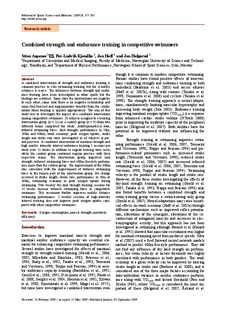| dc.contributor.author | Aspenes, Stian | |
| dc.contributor.author | Kjendlie, Per-Ludvik | |
| dc.contributor.author | Hoff, Jan | |
| dc.contributor.author | Helgerud, Jan | |
| dc.date.accessioned | 2009-11-16T09:41:13Z | |
| dc.date.issued | 2009-09-01 | |
| dc.identifier | Seksjon for fysisk prestasjonsevne / Department of Physical Performance | |
| dc.identifier.citation | Journal of Sports Science and Medicine. 2009, 8(3), 357-365 | en |
| dc.identifier.issn | 1303-2968 | |
| dc.identifier.uri | http://hdl.handle.net/11250/170493 | |
| dc.description | Reprinted from Journal of Sports Science and Medicine, 8, Stian Aspenes,
Per-Ludvik Kjendlie, Jan Hoff and Jan Helgerud, Combined strength and
endurance training in competitive swimmers, Pages No. 357-365,
© Journal of Sports Science and Medicine (2009) with permission from the
JOURNAL OF SPORTS SCIENCE AND MEDICINE. | en |
| dc.description.abstract | A combined intervention of strength and endurance training is common practice in elite swimming training, but the scientific evidence is scarce. The influences between strength and endurance training have been investigated in other sports but the findings are scattered. Some state the interventions are negative to each other, some state there is no negative relationship and some find bisected and supplementary benefits from the combination when training is applied appropriately. The aim of this study was to investigate the impact of a combined intervention among competitive swimmers. 20 subjects assigned to a training intervention group (n = 11) or a control group (n = 9) from two different teams completed the study. Anthropometrical data, tethered swimming force, land strength, performance in 50m, 100m and 400m, work economy, peak oxygen uptake, stroke length and stroke rate were investigated in all subjects at pre and post-test. A combined intervention of maximal strength and high aerobic intensity interval endurance training 2 sessions per week over 11 weeks in addition to regular training were used, while the control group continued regular practice with their respective teams. The intervention group improved land strength, tethered swimming force and 400m freestyle performance more than the control group. The improvement of the 400m was correlated with the improvement of tethered swimming force in the female part of the intervention group. No change occurred in stroke length, stroke rate, performance in 50m or 100m, swimming economy or peak oxygen uptake during swimming. Two weekly dry-land strength training sessions for 11 weeks increase tethered swimming force in competitive swimmers. This increment further improves middle distance swimming performance. 2 weekly sessions of high-intensity interval training does not improve peak oxygen uptake compared with other competitive swimmers. | en |
| dc.format.extent | 281452 bytes | |
| dc.format.mimetype | application/pdf | |
| dc.language.iso | eng | en |
| dc.publisher | Asist group | en |
| dc.subject | oxygen consumption | en |
| dc.subject | muscle strength | en |
| dc.subject | metabolic | en |
| dc.title | Combined strength and endurance training in competitive swimmers | en |
| dc.type | Peer reviewed | en |
| dc.type | Journal article | en |
| dc.subject.nsi | VDP::Social science: 200::Social science in sports: 330::Other subjects within physical education: 339 | en |
| dc.source.pagenumber | 357-365 | en |
| dc.source.volume | 8 | en |
| dc.source.journal | Journal of Sports Science and Medicine | en |
| dc.source.issue | 3 | en |
